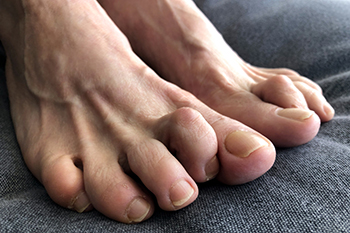Blog
What Is Causing My Ankle Pain?
 The ankle joint is designed to support the whole body through a complex network of bones, muscles, cartilage, ligaments and tendons. Injury or disease to any one of these parts can be debilitating. One of the most common forms of ankle pain is from an ankle sprain. Ankle sprains often occur from stepping on an uneven surface or from a sporting accident that causes the ligaments connecting the bones to become partially or completely torn. Tendonitis is another common cause of ankle pain. Tendonitis occurs when the tendons, which connect the muscles to the bones, become inflamed. Arthritis, which occurs when joints become inflamed, can also lead to ankle pain. There are a variety of other sources of ankle pain, and patients who notice pain in their ankle should consult with a podiatrist for a proper diagnosis and treatment.
The ankle joint is designed to support the whole body through a complex network of bones, muscles, cartilage, ligaments and tendons. Injury or disease to any one of these parts can be debilitating. One of the most common forms of ankle pain is from an ankle sprain. Ankle sprains often occur from stepping on an uneven surface or from a sporting accident that causes the ligaments connecting the bones to become partially or completely torn. Tendonitis is another common cause of ankle pain. Tendonitis occurs when the tendons, which connect the muscles to the bones, become inflamed. Arthritis, which occurs when joints become inflamed, can also lead to ankle pain. There are a variety of other sources of ankle pain, and patients who notice pain in their ankle should consult with a podiatrist for a proper diagnosis and treatment.
Ankle pain can be caused by a number of problems and may be potentially serious. If you have ankle pain, consult with Dr. Kevin Davis from Davis Foot & Ankle Centers. Our doctor will assess your condition and provide you with quality foot and ankle treatment.
Ankle pain is any condition that causes pain in the ankle. Due to the fact that the ankle consists of tendons, muscles, bones, and ligaments, ankle pain can come from a number of different conditions.
Causes
The most common causes of ankle pain include:
- Types of arthritis (rheumatoid, osteoarthritis, and gout)
- Ankle sprains
- Broken ankles
- Achilles tendinitis
- Achilles tendon rupture
- Stress fractures
- Bursitis
- Tarsal tunnel syndrome
- Plantar fasciitis
Symptoms
Symptoms of ankle injury vary based upon the condition. Pain may include general pain and discomfort, swelling, aching, redness, bruising, burning or stabbing sensations, and/or loss of sensation.
Diagnosis
Due to the wide variety of potential causes of ankle pain, podiatrists will utilize a number of different methods to properly diagnose ankle pain. This can include asking for personal and family medical histories and of any recent injuries. Further diagnosis may include sensation tests, a physical examination, and potentially x-rays or other imaging tests.
Treatment
Just as the range of causes varies widely, so do treatments. Some more common treatments are rest, ice packs, keeping pressure off the foot, orthotics and braces, medication for inflammation and pain, and surgery.
If you have any questions, please feel free to contact our office located in Springfield, TN . We offer the newest diagnostic and treatment technologies for all your foot care needs.
What Causes Cracked Heels?
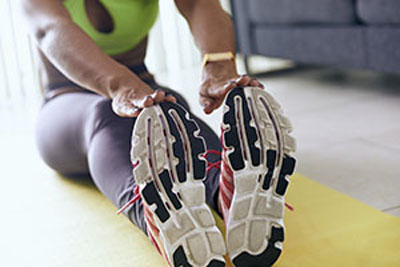 When the skin on the heel dries out and loses its strength and elasticity, the heel becomes hard, dry, and flaky. This leads to splitting, or fissuring and cracking, of skin around the heel which is more commonly known as cracked heels. While cracked heels usually form because of dry skin, wearing open-backed shoes, gaining weight, and increased friction from the back of the shoes can all lead to cracked heels forming as well. Common methods for managing cracked heels include moisturizing the heels twice per day, soaking the feet in warm water, and using a pumice stone on the affected area. However, excessively dry skin can indicate other problems such as neuropathy or diabetes. Patients who continually struggle with cracked heels should consult with a podiatrist to find the source of their issue.
When the skin on the heel dries out and loses its strength and elasticity, the heel becomes hard, dry, and flaky. This leads to splitting, or fissuring and cracking, of skin around the heel which is more commonly known as cracked heels. While cracked heels usually form because of dry skin, wearing open-backed shoes, gaining weight, and increased friction from the back of the shoes can all lead to cracked heels forming as well. Common methods for managing cracked heels include moisturizing the heels twice per day, soaking the feet in warm water, and using a pumice stone on the affected area. However, excessively dry skin can indicate other problems such as neuropathy or diabetes. Patients who continually struggle with cracked heels should consult with a podiatrist to find the source of their issue.
Cracked heels are unsightly and can cause further damage to your shoes and feet. If you have any concerns, contact Dr. Kevin Davis from Davis Foot & Ankle Centers. Our doctor can provide the care you need to keep you pain-free and on your feet.
Cracked Heels
Cracked heels appear unappealing and can make it harder for you walk around in sandals. Aside from looking unpleasant, cracked heels can also tear stockings, socks, and wear out your shoes. There are several methods to help restore a cracked heel and prevent further damage.
How Do You Get Them?
Dry skin is the number one culprit in creating cracked heels. Many athletes, walkers, joggers, and even swimmers suffer from cracked heels. Age and skin oil production play a role to getting cracked heels as well.
Promote Healing
Over the counter medicines can help, especially for those that need instant relief or who suffer from chronic dry feet.
Wear Socks – Wearing socks with medicated creams helps lock in moisture.
Moisturizers – Applying both day and night will help alleviate dryness which causes cracking.
Pumice Stones – These exfoliate and remove dead skin, which allows for smoother moisturizer application and better absorption into the skin.
Change in Diet
Eating healthy with a well-balanced diet will give the skin a fresh and radiant look. Your body responds to the kinds of food you ingest. Omega-3 fatty acids and zinc supplements can also revitalize skin tissue.
Most importantly, seek professional help if unsure how to proceed in treating cracked heels. A podiatrist will help you with any questions or information needed.
If you have any questions, please feel free to contact our office located in Springfield, TN . We offer the newest diagnostic and treatment technologies for all your foot care needs.
Why Treating a Hammertoe Promptly Is Important
Hammertoes are deformities occurring in toes (other than the big toe) where the joint at the base of the toe points up and the middle joint points down. This deformity causes a hammer-like appearance in the affected toe. Hammertoes form over time, and are often the result of wearing shoes that are too short for the foot, pointed at the toes, or have heels that are too high. Other contributing factors may include having a bunion or other condition that squeezes the toes into an unnatural, compacted position. A podiatrist may be able to straighten a hammertoe if they can treat it while it is still flexible. Once a hammertoe becomes rigid, a surgical intervention may be necessary to straighten the toe and return it to its normal range of motion. Call a podiatrist right away if you suspect a hammertoe is developing, in order to increase your chances of having it straightened before it becomes rigid.
Hammertoe
Hammertoes can be a painful condition to live with. For more information, contact Dr. Kevin Davis from Davis Foot & Ankle Centers. Our doctor will answer any of your foot- and ankle-related questions.
Hammertoe is a foot deformity that affects the joints of the second, third, fourth, or fifth toes of your feet. It is a painful foot condition in which these toes curl and arch up, which can often lead to pain when wearing footwear.
Symptoms
- Pain in the affected toes
- Development of corns or calluses due to friction
- Inflammation
- Redness
- Contracture of the toes
Causes
Genetics – People who are genetically predisposed to hammertoe are often more susceptible
Arthritis – Because arthritis affects the joints in your toes, further deformities stemming from arthritis can occur
Trauma – Direct trauma to the toes could potentially lead to hammertoe
Ill-fitting shoes – Undue pressure on the front of the toes from ill-fitting shoes can potentially lead to the development of hammertoe
Treatment
Orthotics – Custom made inserts can be used to help relieve pressure placed on the toes and therefore relieve some of the pain associated with it
Medications – Oral medications such as anti-inflammatories or NSAIDs could be used to treat the pain and inflammation hammertoes causes. Injections of corticosteroids are also sometimes used
Surgery – In more severe cases where the hammertoes have become more rigid, foot surgery is a potential option
If you have any questions please contact our office located in Springfield, TN . We offer the newest diagnostic and treatment technologies for all your foot and ankle needs.
Why Diabetics Should Be Cautious With Their Feet
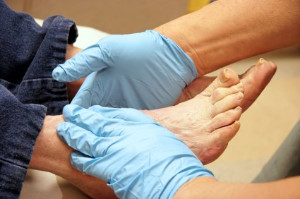 It is estimated that approximately one third of people with diabetes will develop a diabetic foot ulcer. History has shown that diabetics are more likely to have problems and complications related to their feet than others. This is largely to due the fact that the disease raises blood sugar levels, which decreases both sensation and circulation. According to experts, people with diabetes are far less likely to feel pain in their feet. Furthermore, it has been found that 40% of diabetics who develop ulcers will experience some sort of recurrence within a year.
It is estimated that approximately one third of people with diabetes will develop a diabetic foot ulcer. History has shown that diabetics are more likely to have problems and complications related to their feet than others. This is largely to due the fact that the disease raises blood sugar levels, which decreases both sensation and circulation. According to experts, people with diabetes are far less likely to feel pain in their feet. Furthermore, it has been found that 40% of diabetics who develop ulcers will experience some sort of recurrence within a year.
Diabetic foot care is important in preventing foot ailments such as ulcers. If you are suffering from diabetes or have any other concerns about your feet, contact Dr. Kevin Davis from Davis Foot & Ankle Centers. Our doctor can provide the care you need to keep you pain-free and on your feet.
Diabetic Foot Care
Diabetes affects millions of people every year. The condition can damage blood vessels in many parts of the body, especially the feet. Because of this, taking care of your feet is essential if you have diabetes, and having a podiatrist help monitor your foot health is highly recommended.
The Importance of Caring for Your Feet
- Routinely inspect your feet for bruises or sores.
- Wear socks that fit your feet comfortably.
- Wear comfortable shoes that provide adequate support.
Patients with diabetes should have their doctor monitor their blood levels, as blood sugar levels play such a huge role in diabetic care. Monitoring these levels on a regular basis is highly advised.
It is always best to inform your healthcare professional of any concerns you may have regarding your feet, especially for diabetic patients. Early treatment and routine foot examinations are keys to maintaining proper health, especially because severe complications can arise if proper treatment is not applied.
If you have any questions please feel free to contact our office located in Springfield, TN . We offer the newest diagnostic and treatment technologies for all your foot and ankle needs.
What to Do About Foot Pain
 Foot pain can be a very debilitating condition to experience. First, however, it is important to figure out what is causing it. Plantar fasciitis is one of the most common causes of heel pain. Standing for long periods of time and overuse can cause the plantar fascia to become inflamed. Plantar fasciitis can affect anyone. Thankfully there are a number of treatments available for heel pain, with many of them being very easy to do. Keeping pressure off the feet, resting, and avoiding overuse can improve the condition of many who suffer from plantar fasciitis. Another method for treating heel pain includes buying a new pair of well-fitted shoes. Look for a pair that is not too tight or loose for your feet. Shoes should also have enough space in the toe box for your toes to wiggle around. Finally, look for a pair that is comfortable and that would be fine to wear for long periods of time. If you have heel or general foot pain that will not go away, see a podiatrist for a diagnosis and proper treatment.
Foot pain can be a very debilitating condition to experience. First, however, it is important to figure out what is causing it. Plantar fasciitis is one of the most common causes of heel pain. Standing for long periods of time and overuse can cause the plantar fascia to become inflamed. Plantar fasciitis can affect anyone. Thankfully there are a number of treatments available for heel pain, with many of them being very easy to do. Keeping pressure off the feet, resting, and avoiding overuse can improve the condition of many who suffer from plantar fasciitis. Another method for treating heel pain includes buying a new pair of well-fitted shoes. Look for a pair that is not too tight or loose for your feet. Shoes should also have enough space in the toe box for your toes to wiggle around. Finally, look for a pair that is comfortable and that would be fine to wear for long periods of time. If you have heel or general foot pain that will not go away, see a podiatrist for a diagnosis and proper treatment.
Many people suffer from bouts of heel pain. For more information, contact Dr. Kevin Davis of Davis Foot & Ankle Centers. Our doctor can provide the care you need to keep you pain-free and on your feet.
Causes of Heel Pain
Heel pain is often associated with plantar fasciitis. The plantar fascia is a band of tissues that extends along the bottom of the foot. A rip or tear in this ligament can cause inflammation of the tissue.
Achilles tendonitis is another cause of heel pain. Inflammation of the Achilles tendon will cause pain from fractures and muscle tearing. Lack of flexibility is also another symptom.
Heel spurs are another cause of pain. When the tissues of the plantar fascia undergo a great deal of stress, it can lead to ligament separation from the heel bone, causing heel spurs.
Why Might Heel Pain Occur?
- Wearing ill-fitting shoes
- Wearing non-supportive shoes
- Weight change
- Excessive running
Treatments
Heel pain should be treated as soon as possible for immediate results. Keeping your feet in a stress-free environment will help. If you suffer from Achilles tendonitis or plantar fasciitis, applying ice will reduce the swelling. Stretching before an exercise like running will help the muscles. Using all these tips will help make heel pain a condition of the past.
If you have any questions please contact our office located in Springfield, TN . We offer the newest diagnostic and treatment technologies for all your foot and ankle needs.
Common Conditions That Afflict the Foot
 Our feet are an important part of our bodies and require good care to keep us going. Here are some common foot ailments and ways to treat them. A bunion, or the misalignment of the big toe, can be worsened by improper footwear, such as high heels or poorly fitted shoes. To prevent this, wear well-fitted and supportive shoes that provide ample toe space. Calluses and corns are caused by repeated friction on an area, which results in the buildup of hard skin. Preventing friction is the best way to stop both, so wearing quality socks and shoes that don’t rub up against the skin are best. If you do develop calluses or corns, it is recommended to see a podiatrist. Sometimes, viruses can enter the skin on our feet through tiny cuts or scrapes and cause verrucas, or plantar warts. Plantar warts are contagious, so it is recommended to see a podiatrist who can treat them. If you use public showers, wear shower shoes to prevent catching viruses and fungal infections, such as athlete’s foot. Ingrown toenails can occur if pressure is put on the nail or if the nails are cut too short. Athlete’s foot and fungal nails are both caused by fungi. While there are over-the-counter ointments that you can buy, podiatrists can prescribe better options. Finally flat feet, which are caused by fallen arches, can be taken care of with custom-made orthotics from a podiatrist.
Our feet are an important part of our bodies and require good care to keep us going. Here are some common foot ailments and ways to treat them. A bunion, or the misalignment of the big toe, can be worsened by improper footwear, such as high heels or poorly fitted shoes. To prevent this, wear well-fitted and supportive shoes that provide ample toe space. Calluses and corns are caused by repeated friction on an area, which results in the buildup of hard skin. Preventing friction is the best way to stop both, so wearing quality socks and shoes that don’t rub up against the skin are best. If you do develop calluses or corns, it is recommended to see a podiatrist. Sometimes, viruses can enter the skin on our feet through tiny cuts or scrapes and cause verrucas, or plantar warts. Plantar warts are contagious, so it is recommended to see a podiatrist who can treat them. If you use public showers, wear shower shoes to prevent catching viruses and fungal infections, such as athlete’s foot. Ingrown toenails can occur if pressure is put on the nail or if the nails are cut too short. Athlete’s foot and fungal nails are both caused by fungi. While there are over-the-counter ointments that you can buy, podiatrists can prescribe better options. Finally flat feet, which are caused by fallen arches, can be taken care of with custom-made orthotics from a podiatrist.
Everyday foot care is very important to prevent infection and other foot ailments. If you need your feet checked, contact Dr. Kevin Davis from Davis Foot & Ankle Centers. Our doctor can provide the care you need to keep you pain-free and on your feet.
Everyday Foot Care
Often, people take care of their bodies, face and hair more so than they do for their feet. But the feet are a very important aspect of our bodies, and one that we should pay more attention to. Without our feet, we would not be able to perform most daily tasks.
It is best to check your feet regularly to make sure there are no new bruises or cuts that you may not have noticed before. For dry feet, moisturizer can easily be a remedy and can be applied as often as necessary to the affected areas. Wearing shoes that fit well can also help you maintain good foot health, as well as making it easier to walk and do daily activities without the stress or pain of ill-fitting shoes, high heels, or even flip flops. Wearing clean socks with closed shoes is important to ensure that sweat and bacteria do not accumulate within the shoe. Clean socks help to prevent Athlete’s foot, fungi problems, bad odors, and can absorb sweat.
If you have any questions please feel free to contact our office located in Springfield, TN . We offer the newest diagnostic and treatment technologies for all your foot and ankle needs.
Arkansas College Football Player Suffers Achilles Tendon Injury
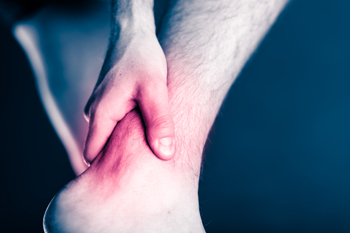 Arkansas Razorbacks wide receiver Jared Cornelius recently injured his left Achilles tendon during the Arkansas and Texas A&M Aggies game. Cornelius suffered the injury during the second half of overtime. As with most injuries of the Achilles tendon, he is expected to be out for the rest of the season. This does not bode well for the Razorbacks, as Cornelius is their leading returning wide receiver. Arkansas was defeated with a final score of 50 to 43.
Arkansas Razorbacks wide receiver Jared Cornelius recently injured his left Achilles tendon during the Arkansas and Texas A&M Aggies game. Cornelius suffered the injury during the second half of overtime. As with most injuries of the Achilles tendon, he is expected to be out for the rest of the season. This does not bode well for the Razorbacks, as Cornelius is their leading returning wide receiver. Arkansas was defeated with a final score of 50 to 43.
Achilles tendon injuries need immediate attention to avoid future complications. If you have any concerns, contact Dr. Kevin Davis of Davis Foot & Ankle Centers. Our doctor can provide the care you need to keep you pain-free and on your feet.
What Is the Achilles Tendon?
The Achilles tendon is a tendon that connects the lower leg muscles and calf to the heel of the foot. It is the strongest tendon in the human body and is essential for making movement possible. Because this tendon is such an integral part of the body, any injuries to it can create immense difficulties and should immediately be presented to a doctor.
What Are the Symptoms of an Achilles Tendon Injury?
There are various types of injuries that can affect the Achilles tendon. The two most common injuries are Achilles tendinitis and ruptures of the tendon.
Achilles Tendinitis Symptoms
- Inflammation
- Dull to severe pain
- Increased blood flow to the tendon
- Thickening of the tendon
Rupture Symptoms
- Extreme pain and swelling in the foot
- Total immobility
Treatment and Prevention
Achilles tendon injuries are diagnosed by a thorough physical evaluation, which can include an MRI. Treatment involves rest, physical therapy, and in some cases, surgery. However, various preventative measures can be taken to avoid these injuries, such as:
- Thorough stretching of the tendon before and after exercise
- Strengthening exercises like calf raises, squats, leg curls, leg extensions, leg raises, lunges, and leg presses
If you have any questions please feel free to contact our office located in Springfield, TN . We offer the newest diagnostic tools and technology to treat your foot and ankle needs.
Toenail Care for the Elderly
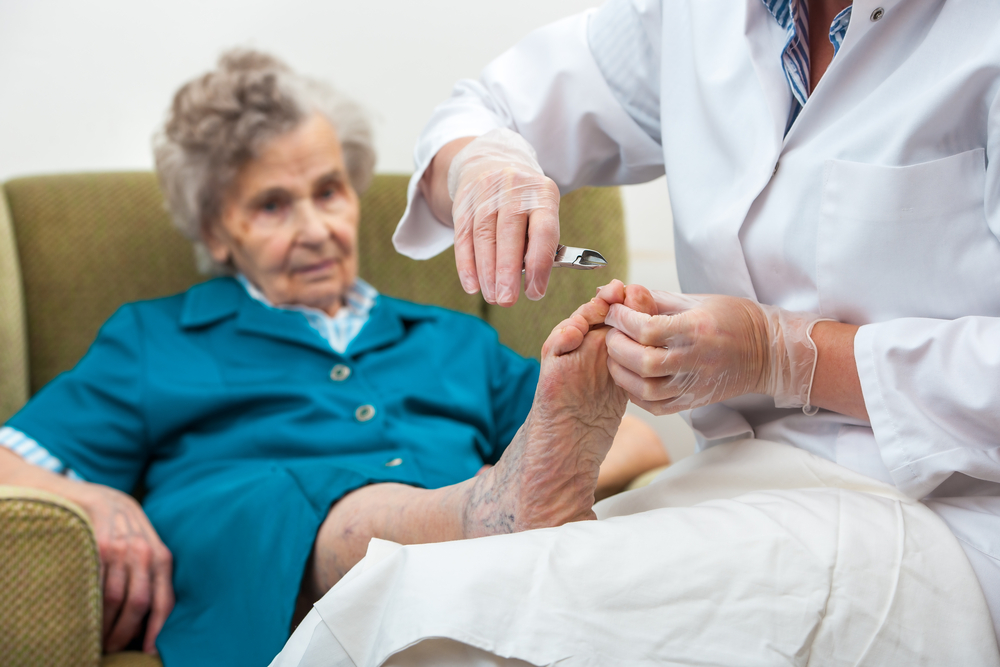 Geriatric (elderly) people may be prone to foot problems, which may include ingrown toenails, corns, and calluses. A reason for this may be their inability to cut their own toenails due to poor eyesight or loss of mobility. A qualified caregiver should be able to cut toenails properly. Ideally, toenails should be kept short, as more problems tend to arise if the nails are too long. The shorter they are, the less risk there is of breaking a nail. As we age, it’s beneficial to stay healthy and active. However, it’s important to remember to practice proper foot care. A podiatrist should be consulted to learn the best options for correct maintenance and treatments.
Geriatric (elderly) people may be prone to foot problems, which may include ingrown toenails, corns, and calluses. A reason for this may be their inability to cut their own toenails due to poor eyesight or loss of mobility. A qualified caregiver should be able to cut toenails properly. Ideally, toenails should be kept short, as more problems tend to arise if the nails are too long. The shorter they are, the less risk there is of breaking a nail. As we age, it’s beneficial to stay healthy and active. However, it’s important to remember to practice proper foot care. A podiatrist should be consulted to learn the best options for correct maintenance and treatments.
If you need your feet checked, contact Dr. Kevin Davis of Davis Foot & Ankle Centers. Our doctor will attend to all of your foot and ankle needs and provide you with quality treatment.
Geriatrics and Podiatry
When people age, some common issues that may occur are bone density loss, dry skin, poor circulation, and rough brittle nails. These issues may also affect your foot health if the necessary steps are not taken to alleviate the problems.
It is important to take care of your feet because feet that are injured or diseased can affect your overall health. Having painful feet hinders your ability to do daily activities or may decrease your willingness to do the things that you need to do.
Visiting Your Geriatrician
As we age, health problems become more likely, so it is essential to visit your doctor for check-ups to ensure that you are doing the best you can to take care of your health. It is recommended to check your feet frequently for any possible cuts, bruises, swelling, corns or any other irregularities.
Taking Care of Elderly Feet
Cracked or dry feet can be treated by applying moisturizer often. It is also important not to wear old socks because the older the sock is, the higher the possibility there will be that there is bacteria there. Wear fresh socks and make sure they fit properly.
Proper foot health means that you can have a more active lifestyle and you will not be bogged down by pain. Foot health also leads to good circulation, which is paramount for overall health.
If you have any questions, please feel free to contact our office located in Springfield, TN . We offer the newest diagnostic tools and technology to treat your foot and ankle needs.
What is Hammertoe and Mallet Toe?
 An imbalance in either the muscles, ligaments, and tendons in the foot that keep the toes straight can cause hammertoe or mallet toe. Causes of this imbalance can stem from improperly-fitted shoes, trauma, and even foot structure. An abnormal bend in the middle joint of a toe is called hammertoe. When the joint nearest to the toenail is affected, this condition is called mallet toe. Poorly-fitted shoes can result in the toes becoming compressed which can result in the condition. Simply wearing properly-fitted footwear may cause the toes to become uncompressed and restore balance in the foot. However, surgery may be needed if the issue stems from trauma or foot structure, and if symptoms become more severe or do not go away.
An imbalance in either the muscles, ligaments, and tendons in the foot that keep the toes straight can cause hammertoe or mallet toe. Causes of this imbalance can stem from improperly-fitted shoes, trauma, and even foot structure. An abnormal bend in the middle joint of a toe is called hammertoe. When the joint nearest to the toenail is affected, this condition is called mallet toe. Poorly-fitted shoes can result in the toes becoming compressed which can result in the condition. Simply wearing properly-fitted footwear may cause the toes to become uncompressed and restore balance in the foot. However, surgery may be needed if the issue stems from trauma or foot structure, and if symptoms become more severe or do not go away.
Hammertoe
Hammertoes can be a painful condition to live with. For more information, contact Dr. Kevin Davis from Davis Foot & Ankle Centers. Our doctor will answer any of your foot- and ankle-related questions.
Hammertoe is a foot deformity that affects the joints of the second, third, fourth, or fifth toes of your feet. It is a painful foot condition in which these toes curl and arch up, which can often lead to pain when wearing footwear.
Symptoms
- Pain in the affected toes
- Development of corns or calluses due to friction
- Inflammation
- Redness
- Contracture of the toes
Causes
Genetics – People who are genetically predisposed to hammertoe are often more susceptible
Arthritis – Because arthritis affects the joints in your toes, further deformities stemming from arthritis can occur
Trauma – Direct trauma to the toes could potentially lead to hammertoe
Ill-fitting shoes – Undue pressure on the front of the toes from ill-fitting shoes can potentially lead to the development of hammertoe
Treatment
Orthotics – Custom made inserts can be used to help relieve pressure placed on the toes and therefore relieve some of the pain associated with it
Medications – Oral medications such as anti-inflammatories or NSAIDs could be used to treat the pain and inflammation hammertoes causes. Injections of corticosteroids are also sometimes used
Surgery – In more severe cases where the hammertoes have become more rigid, foot surgery is a potential option
If you have any questions please contact our office located in Springfield, TN . We offer the newest diagnostic and treatment technologies for all your foot and ankle needs.

